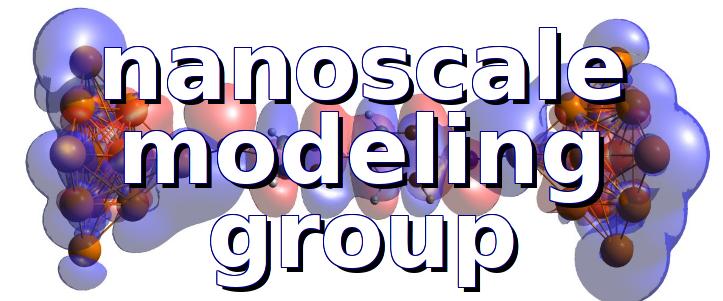


 |

 |
| Home | People | Research | Publications | Seminars | Teaching | New Jobs |
|
INFO => | Library | Events | Links |
|
Welcome to the homepage of the Nanoscale Modeling Group Chair Materials Science and Nanotechnology TU Dresden
Experimental and theoretical investigations of charge and heat transport at nanoscale is the central issue of the rapidly growing fields of molecular electronics and complex nanomaterials. While the final aim of technology is creation of new functional materials and integrated molecular circuits, the basic research is concentrated at the moment on the particular question of the current through single molecules or molecular monolayers placed between metallic, semiconductor, carbon or organic electrodes. In recent years significant progress has been achieved in the experimental realization of molecular junctions and a plethora of interesting phenomena like rectification, negative differential conductance, Coulomb blockade, Kondo effect, vibrational effects, and nanoscale memory effects, among others, have been demonstrated. The transport mechanisms were found to crucially depend on the intrinsic electronic spectrum of the molecular junction, electron-electron and electron-vibron interactions, as well as on the electronic coupling of the molecule to the electrodes and environment. Depending on the ratio between effective Coulomb (or electron-vibron) interaction and coupling to the leads, molecular junctions can be classified into three groups. In the case of very weak coupling, molecular orbitals are not destroyed, strong charge quantization and Coulomb blockade take place and transport is mainly determined by sequential tunneling. In the opposite case of strong coupling to the leads and weak interactions, electron molecular orbitals are hybridized with states in the leads, charge quantization is suppressed, transport is mainly coherent and the conductance is of the order of the conductance quantum. Finally, in the intermediate situation, the effective electron spectrum of a molecule is determined essentially by the hybridization and the interplay between charge quantization and coherent transport may be important. To summarize, the basic properties of molecular junctions were established and possible device applications were outlined. The theoretical treatment of these phenomena requires combined use of ab initio and quantum transport methods. In parallel with the experimental investigations, a number of new theoretical methods were suggested to describe the structure and electronic properties of molecular junctions at the atomistic level, in particular, the DFT+NGF method, combining density functional theory (DFT) and nonequilibrium Green function (NGF) techniques. However, despite the experimental progress and the theoretical efforts, the understanding of the properties of molecules coupled to electrodes, especially the transport properties, is far from being satisfactory. The focus of the Nanoscale Modeling Group is developing and application of ab initio based quantum transport methods to describe nonequilibrium phenomena in molecular nanosystems and nanomaterials. In particular, the current topics are: Ab initio modeling of molecular junctions with semiconductor electrodes; Thermoelectric effects in molecular junctions; Quantum theory of phonon (vibron) thermal flow in molecular junctions; Ab initio modeling of organic molecules on metal and semiconductor surfaces; Kondo effect in strongly asymmetric molecular junctions; Ab initio modeling of DNA sequencing in graphene nanopores; Many-body theory of molecular transport; Carbon electrodes. TopicsFocus topics
|
ContactDr. habil. Dmitry A. Ryndykwww.ryndyk.de dmitry.ryndyk()tu-dresden.de News
|
|||||||||||||||||||||